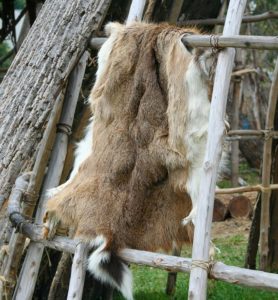This Saturday marks the beginning of firearms season for deer with the advent of the early muzzle loading season. Hunters will be taking to their blinds and stands in their quests for the bucks of their dreams, or at least some meat for their tables.
November always brings nostalgic memories of my dad in his taxidermy shop. This was the busy time of year and it wasn’t uncommon for dad to stay open until 9 or after each evening. Nearly all of the game came in during a short window and all of it had to be processed quickly before spoilage set in to ruin the trophies.
In addition to the heads and antlers, hunters always brought in many deer hides as well. Some of them were to be tanned with the hair on for home or cabin décor while others were made into leather. Each year, a few of them were processed and transformed into fine deerskin coats, handbags, gloves, or slippers that provided incredible comfort and everlasting wear. 
Fresh deer skins were a lot work, however, and had to be fleshed for the removal of meat and fat, salted, and then stored until they could be shipped to the tannery. My brothers and I were employed to flesh these hides using a specially made knife, a wooden beam, and a strong back.
What many customers never realized, however, is that each of their hides had to be personally identified and distinguished from all the others. Although their colorations were virtually identical, some did have slight variations and each had a unique size. When hair is removed and half the skin itself is shaved away, however, how can you be sure the hide you brought in is the one you got back? What would withstand the mechanical and chemical processes used to cure the hide?
Dad had learned a technique to do this during his apprenticeship in Denver. He sued a small sharp awl to puncture the hide with the customer’s ticket number. Instead of using English numerals, though, each digit was punched in in rows. Ticket number 4256 had a row of four holes, followed by a row of two and so forth. These holes were imperceptible from the top side of a hair-on hide, and inconspicuously placed on leather.
After the hides returned from the tannery, dad would find and read these numbers to identify which belonged to whom. Each pierced number indicated ownership. As far as I know, he never had a mix-up and every customer got the same hide back that he brought in.
In a similar fashion, the Bible describes a process whereby indentured Hebrew servants could remain with their masters at the end of their six year terms. If they loved their master and his family, Exodus 21:6 declares that, at the servant’s request, the master was to pierce the servant’s ear with an awl after which the man would serve him for life. Although this sounds very painful, it would forever after signify ownership and identification.
When we come to faith in Jesus, our love for Him and His family motivates us to voluntarily become His. We are added to His ticket. Instead of piercing us, however, He was voluntarily pierced on the cross to make us His own. In addition, Isaiah says He engraves our names on the palm of His hand and will never forget that we belong to Him.
Like the deer hides, we may go through many and serious difficulties. We may get shaved or suffer major losses. We may suffer harsh conditions similar to the tanning process. Through it all, however, God is not only able to identify and claim us at the end, but He is with us through it all. Even though hides may possibly get mixed up and even though our loved ones may one day not recognize us due to dementia or illness, God always knows His own. And He doesn’t need an awl to do it.
If you have given your heart to Jesus, rest assured that He knows your name and will never forget you. Even at times when it feels He is distant or uncaring; remember that He has engraved your name on His own hand. If you don’t know Jesus, you can enjoy this ultimate relationship by responding to His invitation today.
Thankful for His loving care, George